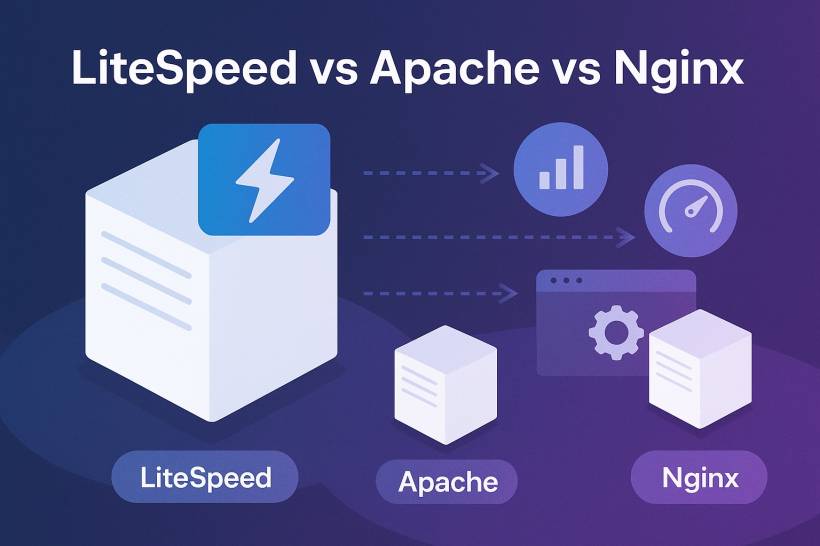When it comes to powering websites, the web server is the engine that makes everything run. Whether you're browsing a WordPress blog, shopping on a Magento store, or streaming media, there's a high chance one of three technologies is serving that content: Apache, Nginx, or LiteSpeed.
Apache has been the long-standing king of web servers, Nginx came in as the lean and efficient challenger, and LiteSpeed has emerged as a performance-focused alternative that blends the best of both worlds. Let's break it down in a conversational way and see what makes each of them unique.
The Basics: How They're Built
Apache has been around since the mid-1990s and for a long time was the default choice. It uses a process or thread-based model, meaning every connection is handled by a separate process or thread. Reliable, yes. Efficient under heavy load? Not really. Nginx was designed later with a different philosophy. It uses an event-driven, asynchronous model that allows a single worker process to handle thousands of connections. This is why Nginx quickly became the go-to option for high-traffic static content. LiteSpeed takes Nginx's event-driven concept and marries it with Apache compatibility. It can read .htaccess files, support mod_rewrite rules, and even run Apache-style security modules while still delivering performance similar to Nginx. So, in short: Apache = compatibility king, Nginx = performance beast, LiteSpeed = hybrid powerhouse.
Performance in the Real World Static Content
If you're serving large amounts of images, CSS, or JavaScript files:
Apache can do the job, but it eats more resources. Nginx shines here—it was practically built for static content. LiteSpeed is on par with Nginx and often edges it out thanks to built-in optimizations. Dynamic Content (PHP-driven sites like WordPress or Joomla)
This is where LiteSpeed really takes the crown.
Apache uses PHP-FPM or mod_php, which introduces overhead. Nginx also uses PHP-FPM, which is better, but still not as efficient. LiteSpeed has LSAPI, a custom PHP handler that keeps processes alive and minimizes overhead, resulting in noticeably faster response times. For WordPress or Magento, LiteSpeed consistently delivers better load times and lower server strain compared to Apache or Nginx.
Caching: The Secret Sauce
Caching is the magic trick that makes websites feel "instant" to users by storing and reusing content instead of generating it fresh each time.
Apache has mod_cache, but it's clunky and not widely used. Nginx has strong caching capabilities, but it often requires custom configurations to handle edge cases like logged-in users or shopping carts. LiteSpeed has LSCache, and this is one of its killer features. It integrates directly with CMS platforms through plugins and can even cache dynamic pages intelligently (think: cache everything except the shopping cart). This means that out of the box, LiteSpeed can turn a slow WordPress site into a lightning-fast experience without complex setup.
Compatibility and Ease of Migration
For many hosting providers, the biggest concern is: Will my websites break if I switch servers?
Apache is the most compatible—it's the standard most CMS platforms were originally built around. Nginx, while powerful, doesn't support .htaccess. If you migrate from Apache, you'll often need to rewrite rules in Nginx syntax. LiteSpeed is fully compatible with Apache configurations, meaning you can drop it in as a replacement and most sites won't even notice the difference—except they'll suddenly load much faster. Security Features
Web servers are constantly in the crosshairs of attackers, so built-in security matters.
Apache supports mod_security (a popular Web Application Firewall). Nginx doesn't include WAF by default, though you can add third-party modules. LiteSpeed supports mod_security rules natively and adds its own DDoS protection features like connection throttling, bandwidth control, and bad bot blocking. For admins who want strong security without stacking multiple tools, LiteSpeed makes things easier.
Protocols of the Future: HTTP/2 and HTTP/3
Web protocols keep evolving, and servers need to keep up.
Apache supports HTTP/2, but QUIC/HTTP/3 isn't native. Nginx supports HTTP/2 and has HTTP/3 support, especially in its commercial version. LiteSpeed was the first commercial web server to support QUIC and HTTP/3, giving it a head start in delivering next-gen browsing experiences, especially for mobile networks. Apache: 100% free, open source. Nginx: Free in its open-source version, but there's also Nginx Plus (a paid enterprise solution). LiteSpeed: Paid commercial license, though there's OpenLiteSpeed as a free alternative. OpenLiteSpeed is great, but it doesn't have all the enterprise goodies (like LSCache for WordPress multisite). If you're running a small site, cost might push you towards Apache or Nginx. But for performance-driven hosting companies, LiteSpeed's license fee is often worth it.
Real-World Scenario
Imagine running a WordPress site with 10,000 daily visitors:
On Apache, you'd see high CPU and memory usage, and your site might lag during traffic spikes. On Nginx, you'd handle static files easily, but you'd still rely on PHP-FPM for WordPress, which can become a bottleneck. On LiteSpeed, LSCache + LSAPI would deliver cached pages to most visitors instantly, while handling PHP far more efficiently in the background. The result? Faster load times, lower resource usage, and better scalability. The Verdict
If we had to summarize:
Apache: Best for legacy support and maximum compatibility. Still solid, but less efficient under heavy traffic. Nginx: Excellent for static content and reverse proxy setups. Lean, fast, and scalable, but less friendly for CMS-driven dynamic sites. LiteSpeed: The modern "all-in-one" option. Blazing fast for both static and dynamic content, with integrated caching, strong security, and Apache compatibility. The only downside is licensing costs.
Feature
|
Apache | Nginx | LiteSpeed |
| Architecture | Process/Thread | Event-driven | Event-driven |
| Static Content | Decent | Excellent | Excellent |
| PHP Performance | Average (PHP-FPM) | Good (PHP-FPM) | Best (LSAPI) |
| Caching | Limited | Strong | Excellent (LSCache) |
| Compatibility | Maximum | Lower | Full Apache-compatible |
| Security | Good | Requires modules | Excellent (built-in WAF, anti-DDoS) |
| Protocols | HTTP/2 | HTTP/2, QUIC/HTTP/3 | HTTP/2, QUIC/HTTP/3 |
| Cost | Free | Free (Plus = Paid) | Paid (OpenLiteSpeed = Free)
|
For small projects, Apache or Nginx might still be enough. But if you're running a busy WordPress, Joomla, or Magento site and want performance without headaches, LiteSpeed is often the winner.





Comments